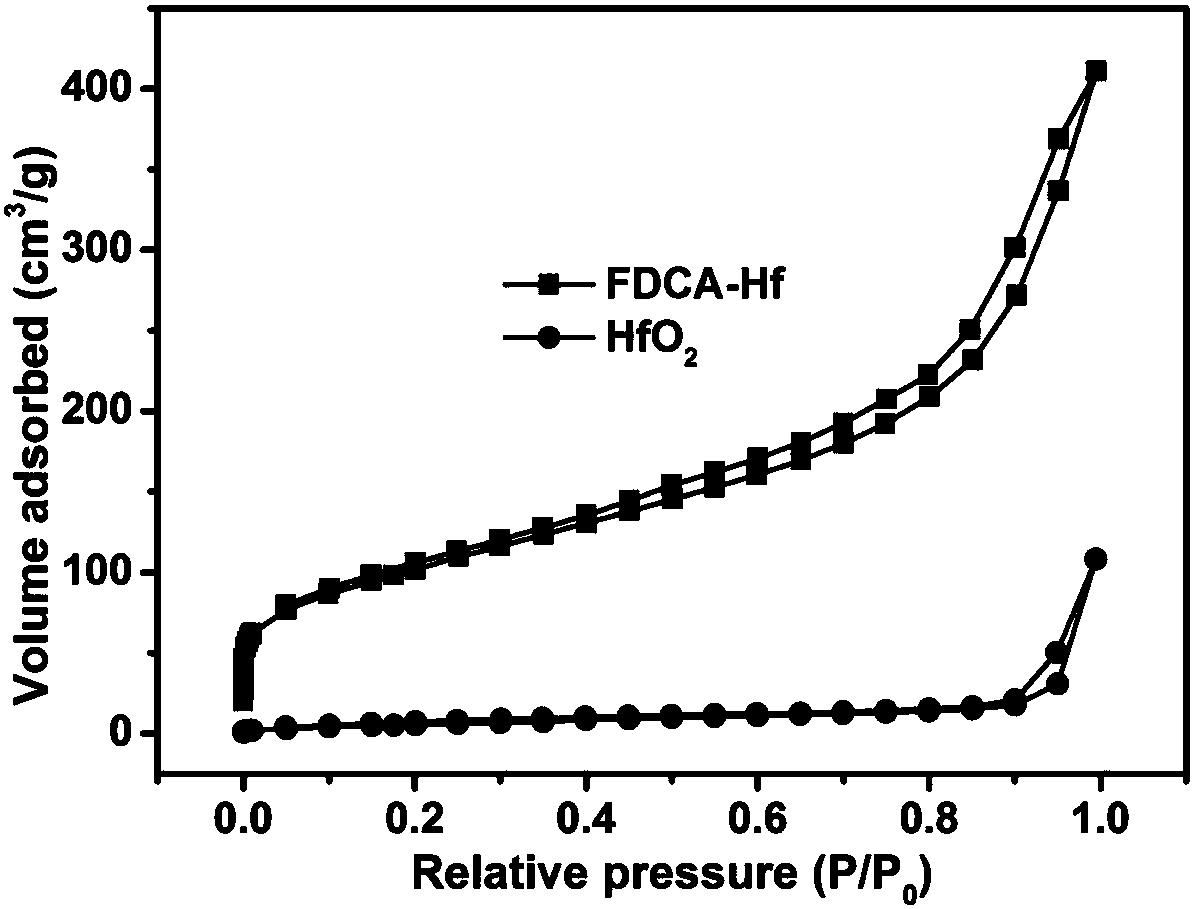Biomass-based furan dicarboxylic acid-metal hybrid material and preparation method and application thereof
A technology based on furandicarboxylic acid and furandicarboxylic acid, which is applied in the field of biomass-based furandicarboxylic acid-metal hybrid materials and its preparation, can solve the problems of low catalytic activity, harsh reaction conditions, and poor stability, and achieve high selectivity , the preparation method is simple, the effect of mild reaction conditions
- Summary
- Abstract
- Description
- Claims
- Application Information
AI Technical Summary
Problems solved by technology
Method used
Image
Examples
Embodiment 1
[0045] (1) Preparation of furandicarboxylic acid-hafnium (FDCA-Hf) hybrid materials
[0046] Weigh 1.5mmol of hafnium tetrachloride (0.48g), 1.5mmol of FDCA (0.23g) and 1mL of formic acid into a hydrothermal reaction polytetrafluoroethylene inner village (volume 25mL) filled with 15.5mL of DMF (200mmol). Stir well at room temperature for 15 min to form a homogeneous mixture. Then, the polytetrafluoroethylene was put into a reactor and sealed, and transferred to a muffle furnace, and left to age at 120° C. for 24 hours. After the heat treatment was completed, the hydrothermal reactor was naturally cooled to room temperature, and the filtered white solid was washed with DMF, ethanol, and acetone three times in sequence, dried in vacuum at 80°C for 5 hours, and finally ground to obtain furandicarboxylic acid-hafnium (FDCA-Hf) hybrid materials.
[0047] Through SEM diagram, TEM diagram, STEM-HAADF element distribution diagram ( figure 1 ) It can be seen that the furandicarboxyl...
Embodiment 2
[0054] Use the catalyst regenerated in Example 1 to catalyze the transfer hydrogenation of ethyl levulinate to prepare γ-valerolactone. The amount of raw materials and reaction conditions are the same as in Example 1. Naphthalene is used as the internal standard to make a standard curve, and the reaction mixture is detected by gas chromatography. The yield of gamma-valerolactone was 97%, and the conversion rate of ethyl levulinate was 100%.
Embodiment 3
[0063] (1) Preparation of furandicarboxylic acid-zirconium (FDCA-Zr) hybrid materials
[0064] Weigh 1mmol of zirconium tetrachloride (0.233g) and 1mmol of FDCA (0.156g) into the hydrothermal reaction polytetrafluoroethylene inner village (25mL in volume) filled with 11.6mL of DMF (150mmol), stir well at room temperature 30min to form a homogeneous mixture. Then, the polytetrafluoroethylene was put into a reaction kettle and sealed, and transferred to a muffle furnace, and aged at 160° C. for 12 hours. After the heat treatment was completed, the hydrothermal reaction vessel was naturally cooled to room temperature, and the filtered white solid was washed three times with DMF, ethanol, and acetone respectively, dried in vacuum at 80°C for 5 hours, and finally ground to obtain a solid catalyst.
[0065] (2) Catalyzing the reduction reaction of ethyl levulinate MPV to prepare γ-valerolactone
[0066] The solid catalyst prepared in this example was used to catalyze the transfer ...
PUM
 Login to View More
Login to View More Abstract
Description
Claims
Application Information
 Login to View More
Login to View More - R&D
- Intellectual Property
- Life Sciences
- Materials
- Tech Scout
- Unparalleled Data Quality
- Higher Quality Content
- 60% Fewer Hallucinations
Browse by: Latest US Patents, China's latest patents, Technical Efficacy Thesaurus, Application Domain, Technology Topic, Popular Technical Reports.
© 2025 PatSnap. All rights reserved.Legal|Privacy policy|Modern Slavery Act Transparency Statement|Sitemap|About US| Contact US: help@patsnap.com



